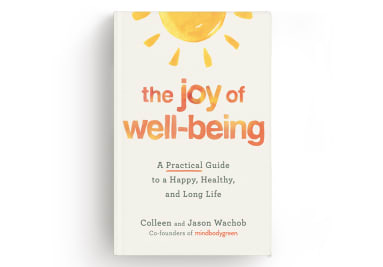
Image by Martí Sans / Stocksy
May 21, 2023
Our editors have independently chosen the products listed on this page. If you purchase something mentioned in this article, we may
There are the obvious ways plastic hurts the earth—the fact that only about 10% of all the plastic manufactured in our lifetimes has been recycled, that marine organisms are killed by the millions because of plastic polluting our oceans, and that plastics manufacturing is a major driver of climate change.
But plastics also act on the human body in invisible and insidious ways. Plastic is, of course, made of and with chemicals, many of which are harmful to human health. They leach into our food from plastic containers, especially when heated, and can also get into the body when babies chew on plastic toys or drink from plastic straws.
Advertisement
This ad is displayed using third party content and we do not control its accessibility features.
All of these exposures are, according to one journal article1, “linked with severe adverse health outcomes such as cancers, birth defects, impaired immunity, endocrine disruption, developmental and reproductive effects.”
While there is a whole alphabet soup of chemicals that are harmful to human health, research has shown phthalates and BPA/BPF/BPS to be particularly dangerous. The former makes plastic soft, like the flimsy water bottle you get at the gas station, and the latter makes plastic hard, like a sturdy reusable water bottle that can go in the dishwasher.
These chemicals interfere with human hormones like estrogen, progesterone, and testosterone, which is why they are commonly referred to as endocrine disruptors. Many scientists and environmental experts have linked the rise of these endocrine disruptors in our environment to disturbances in reproductive function such as declines in fertility, higher rates of miscarriage, and changes to the number and quality of eggs in ovaries. From 1973 to 2011, the total sperm count of Western men dropped by 59% percent, which makes sense when you know that exposure to endocrine-disrupting chemicals can reduce levels of testosterone in males.
Shanna Swan, Ph.D., a leading environmental and reproductive epidemiologist from Mount Sinai Medical Center, found that pregnant women who were exposed to endocrine disruptors were giving birth to male children with measurably smaller penises and anal-genital distance. In other words, the chemicals that the pregnant women were exposed to lowered the testosterone levels in their male fetuses enough to have physically measurable impacts. Scientists have been observing this exposure effect in male frogs, for instance, for decades, but to see it shown in humans is alarming, to say the least.
RELATED READ: These 8 Detox Supplements Are The Best On The Market
How to reduce your plastic exposure at home
There’s no way we’re going to eliminate all exposures, even if we become obsessive about it. So, what should we do? The best we reasonably can. Here’s what that looks like.
Advertisement
This ad is displayed using third party content and we do not control its accessibility features.
1.
Filter your water, or at least don’t drink it from a plastic bottle.
If you have the resources to invest in a home water filter, do it. As we have learned from the ongoing disaster in Flint, Michigan, we can’t always rely on municipalities to alert us to problems with our water supply in a timely fashion. Not to mention, industrial and agricultural chemicals and pharmaceuticals can pollute your water in ways that are not monitored by municipalities.
If you get your drinking water from a well, it’s even more important to filter it, considering what we know about PFAs contaminating groundwater. In short, what we know about water pollution is enough of a reason to be careful with our drinking water—what we don’t yet know about potential exposures should send us running to buy a home filter.
2.
Eliminate plastics around food.
This isn’t as hard as it sounds, because in the past few years there has been more consumer demand for nonplastic alternatives when it comes water bottles and food containers. This makes it easy enough to find your child a stainless steel water bottle or lunchbox, if you’re up for it. The experts say that your best bet for food storage is glass, metal, and ceramics.
If replacing plastic in your home is an expense you can’t take on all at once, that’s okay. You can mitigate your risk by not heating up foods in plastic. It’s as easy as transferring your leftovers to a ceramic plate before you heat them up in the microwave—a small but mighty change.
Advertisement
This ad is displayed using third party content and we do not control its accessibility features.
You should already be in the habit of reading food labels to make sure what you buy is as lightly processed and free from additives as possible. The next step is treating your household cleaners and personal care products with the same scrutiny.
When it comes to cleaning supplies, Swan recommends going through your sprays and cleaners and looking for words like “danger, warning, poison, or fatal.” Swap out those harsh chemical agents with products that are made out of easily identifiable ingredients.
The cosmetics and beauty aisle at your local pharmacy is one of the most confusing places around. Because these products are not regulated as tightly by the Food and Drug Administration, their labels can contain misleading language like “all natural!” or “Pure and clean!”—descriptors that from a regulatory standpoint mean diddly squat.
For personal products, in order to steer clear of harmful chemicals and endocrine disruptors, Swan suggests looking for organic, fragrance-free or safe fragrance, paraben-free, and phthalate-free products when possible.
Excerpted from The Joy of Well-Being by Colleen Wachob and Jason Wachob. Copyright © 2023 by Colleen Wachob and Jason Wachob. Reprinted with permission of Balance Publishing, an imprint of Hachette Book Group. All rights reserved.
Advertisement
This ad is displayed using third party content and we do not control its accessibility features.



